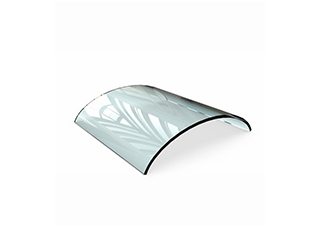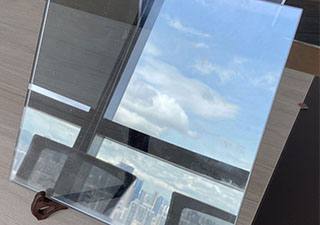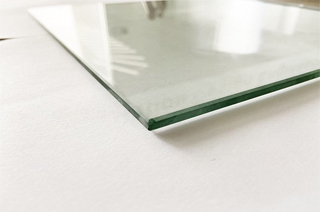Essentially, the material of tempered glass and ordinary glass is similar, there is no special point. What makes toughened glass have a strengthening effect is its unique manufacturing process.
The normal production process of flat glass is: the raw materials are melted at a high temperature to form a uniform and bubble-free glass liquid; when the glass liquid is cooled to a temperature range that can be mechanically processed, it is rolled to form a flat shape; the cooled glass The internal stress is extremely large, and it needs to be annealed again, that is, it is heated at a lower temperature for a period of time and slowly cooled to reduce the internal stress and stabilize the internal structure.
For tempered glass, a strengthening step must be added at the end of the above process. Specifically, after obtaining ordinary glass of a certain size, it is heated to near the softening point of the glass at about 650℃ to 700℃, and then the glass Both sides are blown with high-pressure airflow at the same time to make it cool rapidly. At this time, the glass surface will take the lead in cooling and shrinking, forming a structure with high internal compressive stress in the surface layers on both sides. The cooled central part will then have a high internal tensile stress. In the end, a compressive stress layer of approximately 1/6 glass thickness will be formed on both sides of the glass.
Glass as a material has a very significant property, that is, it is afraid of pulling and not afraid of pressure. It has a strong resistance to external pressure loads, but its ability to withstand tensile loads is much lower. If we support a piece of flat glass with a surrounding frame, just like a glass roof or a bridge deck of a glass bridge. We will find that when the glass is affected by the load, the upper part is still under pressure, but the lower part is actually under tension. When the load gradually increases, the degree of deflection of the glass deepens, and the tensile stress underneath is also increasing. So when the load on the ordinary glass is too large, such as a person standing on it, it is basically the result of breaking, and the cut on the broken surface is very, very sharp.
As a result of the high temperature and rapid cooling of the tempered glass during the production process, the compressive stress area on the two sides of the surface can well offset the load effect, and the tensile stress on the weak side of the glass will not increase to the same level as that of ordinary glass. Prone to breakage. Generally speaking, the strength of strengthened glass can be increased to 3 to 5 times or more.
However, although toughened glass has high strength, it is definitely not indestructible. Tempered glass is actually a material with great internal stress. Under normal circumstances, the compressive stress and tensile stress can be balanced, and the glass can naturally maintain its external state intact. However, once this balance is broken, the huge internal stress will be released instantaneously, and will be transferred from the weak point of the first failure to the whole piece of glass, causing it to quickly break. For example, there is a window breaker on the side of the window glass on a bus. As long as the four rectangular points on the window glass are hit, the window can be completely broken into ballast.

Toughened Glass
How can tempered glass explode without external force?
There are many kinds of weak points that occur first. For example, bumps during glass installation and movement can damage the compressive stress layer on the edge and even the surface, forming cracks. If the crack is deep enough to reach or approach the tensile stress layer, the destruction of the internal balance will cause the tempered glass to break immediately. Therefore, the moving and construction process of tempered glass should be very careful to avoid any defects. Because even a very shallow surface crack will become a weak link for future fractures. Therefore, the self-explosion of the tempered glass in the bathroom of "Xiao Zhang" is likely to have buried hidden dangers at the beginning of the installation.
Of course, there are hidden dangers left when tempered glass leaves the factory, that is, quality problems. For example, impurity particles in the manufacturing process. The most common impurity in glass is nickel sulfide, which accumulates inside the glass in the form of particles. Once subjected to an external force, the area around the nickel sulfide particles often breaks first, and the whole piece of glass will also collapse.
Of course, there are hidden dangers left when tempered glass leaves the factory, and that is quality problems. For example, impurity particles in the manufacturing process. The most common impurity in glass is nickel sulfide, which accumulates inside the glass in the form of particles. Once subjected to an external force, the area around the nickel sulfide particles often breaks first, and the whole piece of glass will also collapse.
Are tempered glass and bulletproof glass the same thing?
Actually, there are two main types of real bulletproof glass. One is transparent polymer materials, such as polycarbonate, PVB resin, polyurethane, etc. In the actual manufacturing process, a multilayer structure is generally used instead of a single thick layer. The other is the inclusion of a transparent organic layer in the middle of the glass, which generally adopts a multi-layer structure, so that although the glass will break after impact, the organic polymer layer can still bond the fragments firmly. Bulletproof glass does not rely on its own solidity to bounce bullets away, but breaks the glass and captures the resin layer to dissipate the kinetic energy of the bullet and stay on the resin layer. Therefore, the current bulletproof glass is getting thicker and thicker in terms of safety, and some can reach more than 30 mm. But there is a problem. Ultraviolet rays can change the properties of the polymer layer and affect the anti-ballistic effect. Therefore, the life of the bullet-proof glass is about 3 to 6 years.
Finally, to summarize, although customized toughened glass has higher strength, its heat-resistant temperature and thermal shock resistance are not higher than ordinary glass, and it is likely to collapse when encountering a sharp change in temperature shock. The surface hardness of tempered glass is actually lower than that of ordinary glass, so it is less wear-resistant in comparison. Tempered glass may disintegrate, because impurities may be mixed in during the production process. The biggest advantage of tempered glass compared with ordinary glass is that it can be reflected in life that when tempered glass is broken, a lot of ballast is produced, while ordinary glass is a large piece of sharp fragments, which is the greatest for our safety. Threatened.





